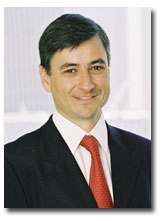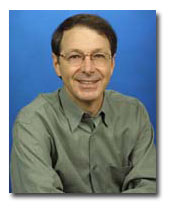BRUSSELS, Belgium, Dec. 6, 2005 — “Innovation is increasingly central to Europe’s future success,” Jean-Philippe Courtois, president of Microsoft International, said in welcoming his audience to the Microsoft European Research and Innovation Day, held today at Concert Noble in Brussels.
The event brought together researchers, academics, policy makers, industry leaders, entrepreneurs and students from across Europe to discuss and demonstrate innovations of the future that are happening now in Europe. The day was capped by a selection of technology demos from Microsoft Research work being done in Cambridge, U.K.; Bangalore, India; Beijing, China; and Redmond, Wash., as well as a select group of Microsoft industry partners.

Jean-Philippe Courtois, President, Microsoft International
Courtois presented one of the two keynote addresses for the event, the other being delivered by Rick Rashid, senior vice president of Microsoft Research.
Rashid spoke about the positive effect innovation can have on jobs and growth in the European Union and its importance to enabling the region to remain competitive in an increasingly competitive global landscape. He also underscored the many partnerships between Microsoft and the IT industry and governments.
“For me, this is really one of the most exciting times that I have ever seen in the field of computer science and computer technology,” Rashid said. “The changes that are going on, and the progress that is being made, are really opening entirely new areas, new vistas, new things that we can do.
“We believe that investing in basic research in computer science is of critical importance at this juncture,” he said. “The opportunities are tremendous, the reasons to invest are tremendous, and we’re not just investing in our own basic research, but we’ve stepped up our investments worldwide, working with universities. We’re reaching out to the top European research institutions and saying, ‘How can we work with you? How can we be a catalyst to help move forward fundamental issues of computer science?’
“We’re investing in students. We’re investing in faculty. And for us, that is a critical part of what we see our mission as being.”
Driving Global Competitiveness
Others who addressed the Brussels audience were Carl Bildt, former prime minister of Sweden and currently a United Nations special envoy, and Andrew Herbert, managing director of Microsoft Research’s Cambridge lab.
“As well as working with universities, with whom we have many of our projects and from whom we recruit many of our staff,” Herbert said, “we also feel a very strong responsibility to help Europe grow going forward and to accelerate the pace of innovation.”

Dr. Richard Rashid, Senior Vice President, Microsoft Research
A panel discussion, “What Is Needed to Drive Europe’s Global Competitiveness,” moderated by Ann Mettler, executive director and co-founder of the Lisbon Council, featured European policy makers, private-sector practitioners, and members of the research and academic communities.
Among them: Jorgo Chatzimarkakis, a German member of the European Parliament and rapporteur for the Report on Competitiveness and Innovation; Rudolf Strohmeier, head of the cabinet for European Commissioner Viviane Reding; Noel Treacy, Irish minister for European Affairs; Carlos Moreira, co-founder, chairman, and co-chief executive officer of WISeKey; Jean Vuillemin, INRIA science director; Colette Leviner, CapGemini global head of Energy, Utilities, and Chemicals, and global head of Marketing; and Reinhilde Veugelers, economic adviser to the European Commission’s Bureau of Economic Policy Analysis.
”What is needed to drive global competitiveness is not an idle question occupying just a few policy wonks and business leaders,” Mettler said. “It is a question that affects each and every one of us in the most profound and most personal way.”
The day’s activities gave participants a chance to learn about various technologies being developed by Microsoft Research and partners that included CapGemini and WISeKey. More than 30 demos offered glimpses into such areas as digital imagery, Web services, social technology in the home, Xbox 360 services and mapping.
Demo: Digital Home Bulletin Board
Among the demos presented was HomeNote, by Abigail Sellen of Microsoft Research’s Cambridge lab. HomeNote is a digital bulletin board, placed in a central location in a home, that enables family members to communicate with one another via text message or digital ink.
“It’s a method of broadcasting to your family,” Sellen said, “but instead of communicating person-to-person, it communicates person-to-place. It might not be a hugely important message, but it’s nice to talk to everyone in the house.”
Another demo was Educational Software for Multiple Input Devices, technology devised by Udai Singh Pawar of Microsoft Research’s lab in Bangalore. That software enables the use of multiple computer mice simultaneously on one computer, using specially designed software that can be used for educational collaboration or competition.
“Normally, in Indian schools, a computer is shared by many children,” Pawar explained. “We are giving them a way to work together on the same computer, basically by giving them their own mouse and their own pointer.”
Synthesizing Images
A third demo, presented by Jonathan Tien of Microsoft Research’s Beijing lab, was called Image Completion with Structure Propagation. It enables its user to remove an unwanted image from a digital photo, then recreate the scene realistically by synthesizing the part of the photo that the unwanted image – say, a stranger who had inadvertently been included in a vacation snapshot – had blocked.
“We’re all taking digital photos now, but they’re never perfect,” Tien observed. “So we want to create an image that they really want. You can take something out; that technology already exists. But after you take something out, you end up having this empty region. You want to fill this nice image, not just have a black hole. We allow people to draw lines on the image, and the computer can generate borders. Then you can patch these different regions with the type of background that the removed image had blocked.”
From keynotes to panel to demos, attendees of the Microsoft European Research and Innovation Day got an opportunity to examine both the concept of innovation in a European setting and to view a sampling of the kinds of research that are driving the technological advances of the future.
“Historically, Europe has a strong tradition of innovation,” said Treacy, the Irish European Affairs minister. “We must nurture and rekindle this tradition. Events such as this organized in Brussels by Microsoft today are very important, as they allow us to share information and to build collectively on our strengths.”




